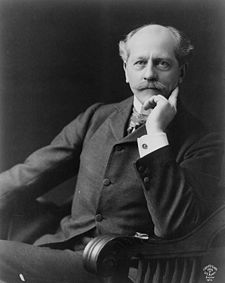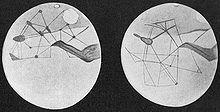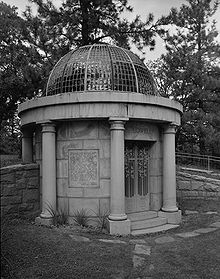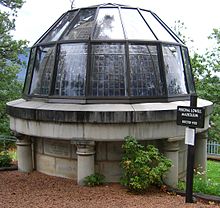- Percival Lowell
-
Percival Lowell 
Percival LowellBorn March 13, 1855
Boston, MassachusettsDied November 12, 1916 (aged 61)
Flagstaff, ArizonaFields astronomy Known for Martian canals, Asteroids discovered: 793 Arizona (April 9, 1907) Percival Lawrence Lowell (March 13, 1855–November 12, 1916) was a businessman, author, mathematician, and astronomer who fueled speculation that there were canals on Mars, founded the Lowell Observatory in Flagstaff, Arizona, and formed the beginning of the effort that led to the discovery of Pluto 14 years after his death. The choice of the name Pluto and its symbol were partly influenced by his initials PL.
Contents
Biography
Percival Lowell was a descendant of the Boston Lowell family. His brother A. Lawrence was the president of Harvard University, and his sister Amy was an imagist poet, critic, and publisher.[1]
Percival graduated from the Noble and Greenough School in 1872 and Harvard University in 1876 with distinction in mathematics.[1] At his college graduation, he gave a speech, considered very advanced for its time, on the "Nebular Hypothesis." He was later awarded honorary degrees from Amherst College and Clark University.[2]
In the 1880s, Lowell traveled extensively in the Far East. In August 1883, he served as a foreign secretary and counsellor for a special Korean diplomatic mission to the United States. He also spent significant periods of time in Japan, writing books on Japanese religion, psychology, and behavior. His texts are filled with observations and academic discussions of various aspects of Japanese life, including language, religious practices, economics, travel in Japan, and the development of personality. Books by Percival Lowell on the Orient include Chosön: The Land of the Morning Calm (1886, Boston), Noto: An Unexplored Corner of Japan (1891) and Occult Japan, or the Way of the Gods (1894); the latter from his third and final trip to the region. The most popular of Lowell's books on the Orient, The Soul of the Far East, (1888) contains an early synthesis of some of his ideas, that in essence, postulated that human progress is a function of the qualities of individuality and imagination.
He was elected a Fellow of the American Academy of Arts and Sciences in 1892.[3] Beginning in the winter of 1893-94, using his wealth and influence, Lowell dedicated himself to the study of astronomy, founding the observatory which bears his name.[4] For the last 23 years of his life astronomy, Lowell Observatory, and his and others' work at his observatory were the focal points of his life. He lived to be 61 years of age.
World War I very much saddened Lowell, a dedicated pacifist. This, along with some setbacks in his astronomical work (described below), undermined his health and contributed to his death from a stroke on November 12, 1916.[5]
Another of his books is The Eve of the French Revolution (1892).[6] Lowell is buried on Mars Hill near his observatory.
Astronomy career
Lowell became determined to study Mars and astronomy as a full-time career after reading Camille Flammarion's La planète Mars.[7] He was particularly interested in the canals of Mars, as drawn by Italian astronomer Giovanni Schiaparelli, who was director of the Milan Observatory.
In 1894 Lowell chose Flagstaff, Arizona Territory as the home of his new observatory. At an altitude of over 2100 meters (7000 feet), with few cloudy nights, and far from city lights, Flagstaff was an excellent site for astronomical observations. This marked the first time an observatory had been deliberately located in a remote, elevated place for optimal seeing.[8]
For the next fifteen years he studied Mars extensively, and made intricate drawings of the surface markings as he perceived them. Lowell published his views in three books: Mars (1895), Mars and Its Canals (1906), and Mars As the Abode of Life (1908). With these writings, Lowell more than anyone else popularized the long-held belief that these markings showed that Mars sustained intelligent life forms.[9]
His works include a detailed description of what he termed the 'non-natural features' of the planet's surface, including especially a full account of the 'canals,' single and double; the 'oases,' as he termed the dark spots at their intersections; and the varying visibility of both, depending partly on the Martian seasons. He theorized that an advanced but desperate culture had built the canals to tap Mars' polar ice caps, the last source of water on an inexorably drying planet.[10]
While this idea excited the public, the astronomical community was skeptical. Many astronomers could not see these markings, and few believed that they were as extensive as Lowell claimed. As a result, Lowell and his observatory were largely ostracized.[11] Although the consensus was that some actual features did exist which would account for these markings,[12] in 1909 the sixty-inch Mount Wilson Observatory telescope in Southern California allowed closer observation of the structures Lowell had interpreted as canals, and revealed irregular geological features, probably the result of natural erosion.[13]
The existence of canal-like features would not be definitively disproved until Mariner 4 took the first close-up pictures of Mars in 1965, and Mariner 9 orbited and mapped the planet in 1972. Today, the surface markings taken to be canals are regarded as an optical illusion.[14]
Although Lowell was better known for his observations of Mars, he also drew maps of the planet Venus. Lowell observed spoke-like features and a central dark spot, yet it is now known that Venus' atmosphere is opaque. In an article published in Sky and Telescope in July 2003, it was suggested that in fact Lowell was observing an image of the blood vessels in his own eye.[15]
Pluto
Lowell's greatest contribution to planetary studies came during the last decade of his life, which he devoted to the search for Planet X, a hypothetical planet beyond Neptune. Lowell believed that the planets Uranus and Neptune were displaced from their predicted positions by the gravity of the unseen Planet X.[16] Lowell started a search program in 1906 using a camera 5 inches (13 cm) in aperture.[17] The small field of view of the 42-inch (110 cm) reflecting telescope rendered the instrument impractical for searching.[17] From 1914 to 1916, a 9-inch (23 cm) telescope on loan from Sproul Observatory was used to search for Planet X.[17] Although Lowell did not discover Pluto, Lowell Observatory (690) did photograph Pluto in March and April 1915.[18]
In 1930 Clyde Tombaugh, working at the Lowell Observatory, discovered Pluto near the location expected for Planet X. Partly in recognition of Lowell's efforts, a stylized P-L monogram (
 )— (the first two letters of the new planet's name and also Lowell's initials), was chosen as Pluto's astronomical symbol.[16] However, it would subsequently emerge that the Planet X theory was mistaken.
)— (the first two letters of the new planet's name and also Lowell's initials), was chosen as Pluto's astronomical symbol.[16] However, it would subsequently emerge that the Planet X theory was mistaken.Pluto's mass could not be determined until 1978, when a satellite came close enough for observation. This confirmed what had been increasingly suspected: Pluto's gravitational influence on Uranus and Neptune is negligible, certainly not nearly enough to account for the discrepancies in their orbits.[19] In 2006, Pluto was reclassified as a dwarf planet by the International Astronomical Union.
In addition, it is now known that the discrepancies between the predicted and observed positions of Uranus and Neptune were not caused by the gravity of an unknown planet. Rather, they were due to an erroneous value for the mass of Neptune. Voyager 2's 1989 encounter with Neptune yielded a more precise value of its mass, and the discrepancies disappear when using this value.[20]
Legacy
Although Lowell's theories of the Martian canals, of surface features on Venus, and of Planet X are now discredited, his practice of building observatories at the position where they would best function has been adopted as a principle.[16] He also established the program and setting which made the discovery of Pluto by Clyde Tombaugh possible.[21] Craters on the Moon and on Mars have been named after him. Lowell has been described by other planetary scientists as "the most influential popularizer of planetary science in America before Carl Sagan."[22]
While eventually disproved, Lowell's vision of the Martian canals as an artifact of an ancient civilization making a desperate last effort to survive, had an enormous influence on the development of Science Fiction - starting with H.G. Wells' enormously influential "The War of the Worlds" which made the logical further inference that creatures from a dying planet might seek to invade Earth.
The image of the dying Mars and its ancient culture was retained, in numerous versions and variations, in most SF works depicting Mars in the first half of the Twentieth Century (see Mars in fiction). Also when proven to be factually mistaken, the vision of Mars derived from his theories remains enshrined in works which remain in print and widely read as classics of Science Fiction.
See also
Notes
- ^ a b Littmann, Mark (1985). Planets Beyond: Discovering the Outer Solar System. Courier Dover Publication. p. 62. ISBN 0486436020.
- ^ Happy Birthday Percival Lowell, First Man to Imagine Life on Mars
- ^ "Book of Members, 1780-2010: Chapter L". American Academy of Arts and Sciences. http://www.amacad.org/publications/BookofMembers/ChapterL.pdf. Retrieved 16 April 2011.
- ^ Littmann, Mark (1985). Planets Beyond: Discovering the Outer Solar System. Courier Dover Publication. pp. 62–3. ISBN 0486436020.
- ^ Croswell, Kenneth, Planet Quest: The Epic Discovery of Alien Solar Systems (1997), pg. 49
- ^
 "Lowell, Percival". Appletons' Cyclopædia of American Biography. 1900.
"Lowell, Percival". Appletons' Cyclopædia of American Biography. 1900. - ^ Chambers P. (1999). Life on Mars; The Complete Story. London: Blandford. ISBN 0713727470
- ^ Littman, Mark, Planets Beyond: Discovering the Outer Solar System (1990), pg. 62
- ^ Kidger, Mark, Astronomical Enigmas: Life on Mars, the Star of Bethlehem, and Other Milky Way Mysteries (2005), pg. 110
- ^ Guthke, Karl S. (1990). The Last Frontier: Imagining Other Worlds from the Copernican Revolution to Modern Fiction. Translated by Helen Atkins. Cornell University Press. pp. 355-6. ISBN 0-8014-1680-9.
- ^ Croswell, pg. 48
- ^ Kidger; pg. 111
- ^ Guthke, Karl S. (1990). The Last Frontier: Imagining Other Worlds from the Copernican Revolution to Modern Fiction. Translated by Helen Atkins. Cornell University Press. pp. 356. ISBN 0-8014-1680-9.
- ^ Baxter, Stephen (2005). Glenn Yeffeth. ed. "H.G. Wells’ Enduring Mythos of Mars". War of the Worlds: fresh perspectives on the H.G. Wells classic/ edited by Glenn Yeffeth (BenBalla): 186–7. ISBN 1932100555.
- ^ SkyandTelescope.com - News from Sky & Telescope - Venus Spokes: An Explanation at Last?
- ^ a b c Rabkin, Eric S. (2005). Mars: a tour of the human imagination. Greenwood Publishing Group. p. 95. ISBN 0275987191.
- ^ a b c Tombaugh, C. W. (1946). "The Search for the Ninth Planet, Pluto". Astronomical Society of the Pacific Leaflets 5: 73–80. Bibcode 1946ASPL....5...73T.
- ^ Marc W. Buie (2008-08-11). "Orbit Fit and Astrometric record for 134340". SwRI (Space Science Department). http://www.boulder.swri.edu/~buie/kbo/astrom/134340.html. Retrieved 2010-02-21.
- ^ Kutner, Marc Leslie (2003). Astronomy: A Physical Perspective. Cambridge University Press. p. 523. ISBN 0521529271.
- ^ Standage, Tom, The Neptune File: A Story of Astronomical Rivalry and the Pioneers of Planet Hunting (2000), pg. 188
- ^ Shaw, H.R. (1994). Craters, Cosmos, and Chronicles: A New Theory of Earth. Stanford University Press. p. 494. ISBN 0804721319.
- ^ Zahnle, K. et al. (2007). "Emergence of a Habitable Planet". Space Science Review 129 (1–3): 35–78. Bibcode 2007SSRv..129...35Z. doi:10.1007/s11214-007-9225-z.
Publication
- Percival Lowell - Collected Writings on Japan and Asia, including Letters to Amy Lowell and Lafcadio Hearn, 5 vols., Tokyo: Edition Synapse. ISBN 978-4-901481-48-9 www.aplink.co.jp/synapse/4-901481-48-7.htm
References
- Zahnel K. (2001). "Decline and Fall of the Martian Empire". Nature 412 (6843): 209–213. doi:10.1038/35084148. PMID 11449281.
- Crossley R. (2000). "Percival Lowell and the history of Mars". Massachusetts Review 41 (3): 297–318.
- Strauss D. (1994). "Lowell, Percival, Pickering, W.H. and the founding of the Lowell Observartory". Annals of Science 51 (1): 37–58. doi:10.1080/00033799400200121.
- Trefil J. (1988). "Turn-of-the-Century American Astronomer Lowell, Percival". Smithsonian 18 (10): 34–.
- Meyer W. B. (1984). "Life on Mars is almost Certain + Lowell,Percival on Exobiology". American Heritage 35 (2): 38–43.
- Hetherington N. S. (1981). "Lowell, Percival - Professional Scientist or Interloper". Journal of the History of Ideas (Journal of the History of Ideas, Vol. 42, No. 1) 42 (1): 159–161. doi:10.2307/2709423. JSTOR 2709423.
- Heffernan W. C. (1981). "Lowell, Percival and the Debate over Extraterrestrial Life". Journal of the History of Ideas (Journal of the History of Ideas, Vol. 42, No. 3) 42 (3): 527–530. doi:10.2307/2709191. JSTOR 2709191.
- Webb G. E. (1980). "The Planet Mars and Science in Victorian America". Journal of American Culture 3 (4): 573. doi:10.1111/j.1542-734X.1980.0304_573.x.
- Hoyt W. G., Wesley W. G. (1977). "Lowell and Mars". American Journal of Physics 45 (3): 316–317. Bibcode 1977AmJPh..45..316H. doi:10.1119/1.10630.
- Hofling C. K. (1964). "Percival Lowell and the Canals of Mars". British Journal of Medical Psychology 37 (1): 33–42. doi:10.1111/j.2044-8341.1964.tb01304.x.
External links
- Works by Percival Lowell at Project Gutenberg
- Lowell Observatory
- BBC Science: Percival Lowell
- Percival Lowell at Find a Grave
Categories:- 1855 births
- 1916 deaths
- American astronomers
- American pacifists
- Asteroid discoverers
- Pluto
- Harvard University alumni
- People from Flagstaff, Arizona
- People from Boston, Massachusetts
- Fellows of the American Academy of Arts and Sciences
Wikimedia Foundation. 2010.




